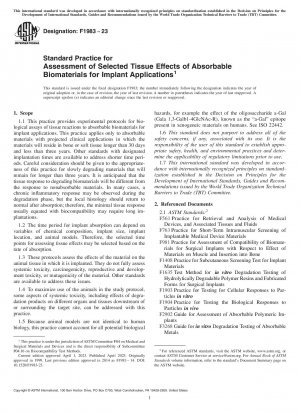ASTM F1983-23
Standard Practice for Assessment of Selected Tissue Effects of Absorbable Biomaterials for Implant Applications
- Standard No.
- ASTM F1983-23
- Release Date
- 2023
- Published By
- American Society for Testing and Materials (ASTM)
- Latest
- ASTM F1983-23
- Scope
- 1.1 This practice provides experimental protocols for biological assays of tissue reactions to absorbable biomaterials for implant applications. This practice applies only to absorbable materials with projected clinical applications in which the materials will reside in bone or soft tissue longer than 30 days and less than three years. Other standards with designated implantation times are available to address shorter time periods. Careful consideration should be given to the appropriateness of this practice for slowly degrading materials that will remain for longer than three years. It is anticipated that the tissue response to degrading biomaterials will be different from the response to nonabsorbable materials. In many cases, a chronic inflammatory response may be observed during the degradation phase, but the local histology should return to normal after absorption; therefore, the minimal tissue response usually equated with biocompatibility may require long implantations. 1.2 The time period for implant absorption can depend on variables of chemical composition, implant size, implant location, and animal models. Therefore, the selected time points for assessing tissue effects may be selected based on the rate of absorption. 1.3 These protocols assess the effects of the material on the animal tissue in which it is implanted. They do not fully assess systemic toxicity, carcinogenicity, reproductive and development toxicity, or mutagenicity of the material. Other standards are available to address these issues. 1.4 To maximize use of the animals in the study protocol, some aspects of systemic toxicity, including effects of degradation products on different organs and tissues downstream of or surrounding the target site, can be addressed with this practice. 1.5 Because animal models are not identical to human biology, this practice cannot account for all potential biological hazards, for example the effect of the oligosaccharide a-Gal (Gala 1,3-Galb1-4GlcNAc-R), known as the “a-Gal” epitope present in xenogeneic materials on humans. See ISO 22442. 1.6 This standard does not purport to address all of the safety concerns, if any, associated with its use. It is the responsibility of the user of this standard to establish appropriate safety, health, and environmental practices and determine the applicability of regulatory limitations prior to use. 1.7 This international standard was developed in accordance with internationally recognized principles on standardization established in the Decision on Principles for the Development of International Standards, Guides and Recommendations issued by the World Trade Organization Technical Barriers to Trade (TBT) Committee.
ASTM F1983-23 Referenced Document
- ASTM F1408 Standard Practice for Subcutaneous Screening Test for Implant Materials
- ASTM F1635 Standard Test Method for In Vitro Degradation Testing of Poly (L-lactic Acid) Resin and Fabricated Form for Surgical Implants
- ASTM F1903 Standard Practice for Testing for Biological Responses to Particles In Vitro
- ASTM F1904 Standard Practice for Testing the Biological Responses to Particles In Vivo
- ASTM F2902 Standard Guide for Assessment of Absorbable Polymeric Implants
- ASTM F3268 Standard Guide for
in vitro Degradation Testing of Absorbable Metals*, 2024-04-22 Update - ASTM F561 Practice for Retrieval and Analysis of Implanted Medical Devices, and Associated Tissues
- ASTM F763 Standard Practice for Short-Term Screening of Implant Materials
- ASTM F981 Standard Practice for Assessment of Compatibility of Biomaterials for Surgical Implants with Respect to Effect of Materials on Muscle and Bone
- ISO 10993-6 Biological evaluation of medical devices - Part 6: Tests for local effects after implantation
- ISO 10993-9 Biological evaluation of medical devices — Part 9: Framework for identification and quantification of potential degradation products
- ISO 13781 Implants for surgery - Homopolymers, copolymers and blends on poly(lactide) - In vitro degradation testing
- ISO 22442 Medical devices utilizing animal tissues and their derivatives - Part 3: Validation of the elimination and/or inactivation of viruses and transmissible spongiform encephalopathy (TSE) agents
- ISO/TS 17137 Cardiovascular implants and extracorporeal systems - Cardiovascular absorbable implants
- ISO/TS 37137-1 Biological evaluation of absorbable medical devices — Part 1: General requirements
ASTM F1983-23 history
- 2023 ASTM F1983-23 Standard Practice for Assessment of Selected Tissue Effects of Absorbable Biomaterials for Implant Applications
- 2014 ASTM F1983-14 Standard Practice for Assessment of Selected Tissue Effects of Absorbable Biomaterials for Implant Applications
- 2008 ASTM F1983-99(2008) Standard Practice for Assessment of Compatibility of Absorbable/Resorbable Biomaterials for Implant Applications
- 2003 ASTM F1983-99(2003) Standard Practice for Assessment of Compatibiltiy of Absorbable/Resorbable Biomaterials for Implant Applications
- 1999 ASTM F1983-99 Standard Practice for Assessment of Compatibiltiy of Absorbable/Resorbable Biomaterials for Implant Applications
